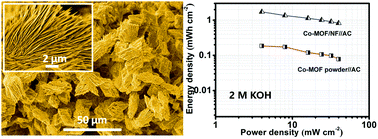A self-supported hierarchical Co-MOF as a supercapacitor electrode with ultrahigh areal capacitance and excellent rate performance†
Abstract
Metal–organic frameworks (MOFs) have emerged as attractive electrode materials for applications in energy storage and conversion, owing to their high porosity and surface area. In this communication, we report a hierarchically structured Co-MOF supported on nickel foam (Co-MOF/NF) serving as a high-performance electrode material for supercapacitors. The as-obtained Co-MOF/NF exhibits an ultrahigh areal specific capacitance of 13.6 F cm−2 at 2 mA cm−2 in 2 M KOH, exceeding those of the previously reported MOF-based materials. It also shows an excellent rate performance of 79.4% at a current density of 20 mA cm−2. An asymmetric supercapacitor (ASC) device employing Co-MOF/NF as the positive electrode and activated carbon (AC) as the negative electrode achieves a high energy density of 1.7 mW h cm−2 at a power density of 4.0 mW cm−2 with a capacitance retention of 69.7% after 2000 cycles.



 Please wait while we load your content...
Please wait while we load your content...